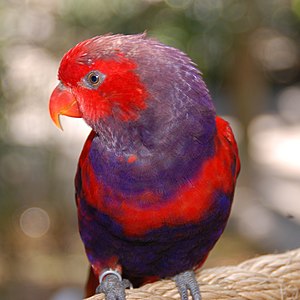Eos (genus)
| Eos | |
|---|---|
 |
|
| Violet-necked lory (Eos squamata) | |
| Scientific classification | |
| Kingdom: | Animalia |
| Phylum: | Chordata |
| Class: | Aves |
| Order: | Psittaciformes |
| Superfamily: | Psittacoidea |
| Family: | Psittaculidae |
| Subfamily: | Loriinae |
| Tribe: | Loriini |
| Genus: |
Eos Wagler, 1832 |
| Species | |
|
6, see text. |
|
6, see text.
Eos is a genus of parrots belonging to the lories and lorikeets tribe of the family Psittaculidae. There are six species which are all endemic to islands of eastern Indonesia, most within very restricted ranges. They have predominantly red plumage with blue, purple or black markings. Males and females are similar in appearance.
Their habitats include forest, coconut plantations and mangroves. They gather in flowering trees to feed on nectar and pollen with their brush-tipped tongues. Fruit and insects are also eaten. They make nests in tree hollows generally high in old large trees. Threats to these parrots include habitat loss and trapping for the cagebird trade, and one species, the red-and-blue lory, is classified as endangered.
The plumage of Eos lories is predominantly red, set off with blue, purple or black markings. They range in length from 24 cm (9.5 in) in the blue-eared lory to 31 cm (12 in) in several of the larger species. The bill is orange-red, the irises are reddish to reddish-brown, and the legs are grey. Males and females are identical in external appearance. They have a musky odour, especially noticeable in the black-winged lory, which is retained even in museum skins. Juvenile birds are partly owing to feathers with darker or dusky tips, and they have orange-brown to black beaks.
Species in the genus Eos are distinguished from lories in the genus Chalcopsitta by shorter tails and the absence of a bare patch of skin around the mandibles. The Eos genus does not have green plumage, which helps to identify them from some species of other lory genera.
...
Wikipedia
